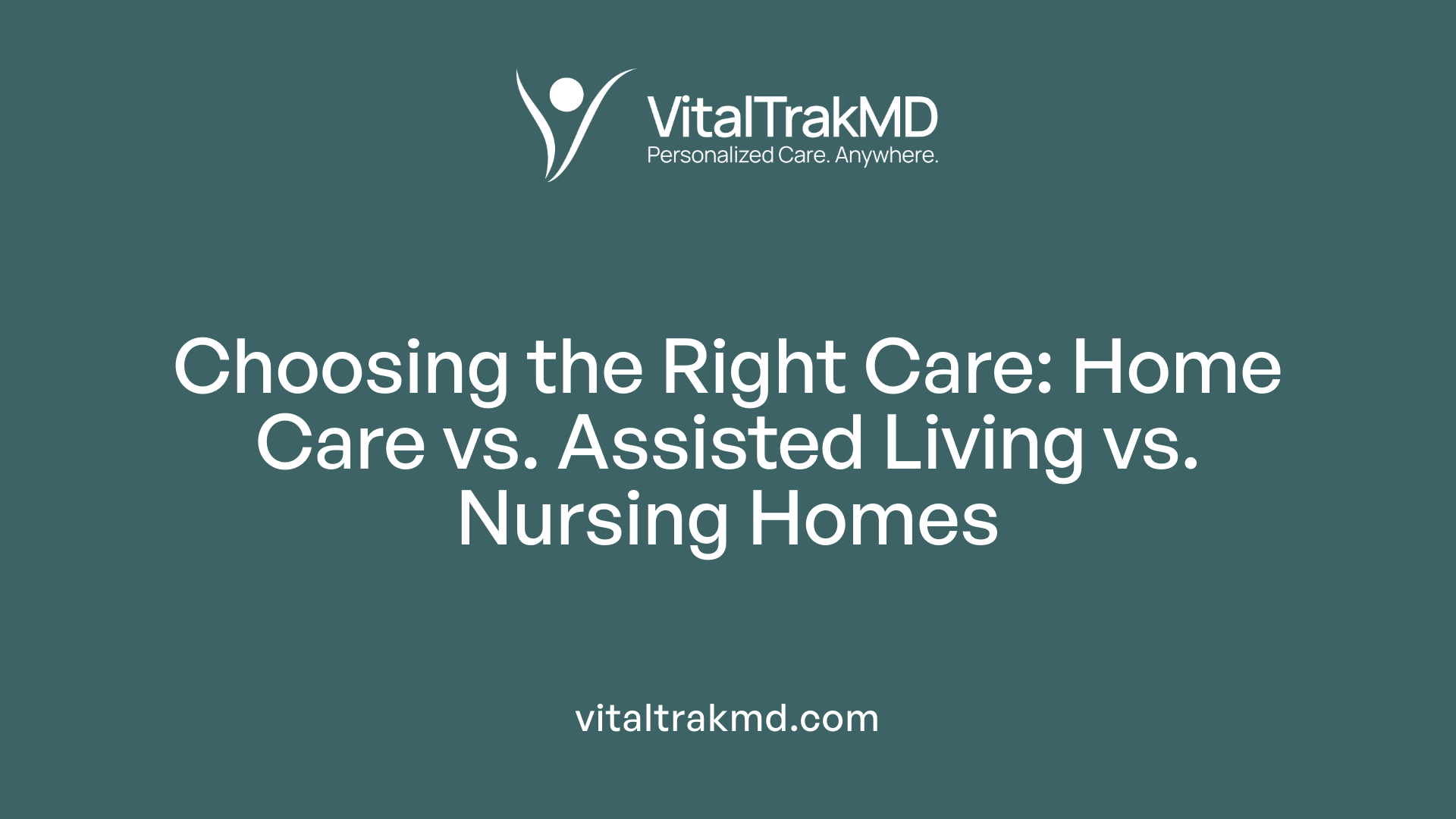Why More Seniors Are Choosing Home-Based Healthcare

Understanding the Shift Towards Home-Based Healthcare for Seniors
As the aging population continues to grow, an increasing number of older adults are opting to receive healthcare services in the comfort of their own homes. This shift is driven by multiple factors including demographic trends, technological advancements, and changing perceptions of care. The trend towards aging in place highlights the importance of personalized, flexible, and cost-effective healthcare models that support independence and emotional well-being. This article explores why more seniors are choosing home-based healthcare, examining recent innovations, societal influences, and the benefits that make this approach a compelling alternative to traditional institutional care.
Demographics and the Surge in Home Healthcare Demand

What are the reasons seniors are increasingly choosing home-based healthcare?
The growing preference among seniors for home-based healthcare is driven by several interconnected factors. First, demographic shifts have led to a significant increase in the elderly population. By 2030, it is projected that one in every five Americans will be aged 65 or older, reflecting the aging of the vast baby boomer generation born between 1946 and 1964.
This demographic transformation results in a higher prevalence of chronic conditions, disabilities, and health complexities among older adults, which necessitate ongoing medical attention, often best managed in a home setting. Many seniors also have multiple chronic illnesses, which require regular management, medication adherence, and monitoring—services that are effectively delivered through home healthcare.
Advances in healthcare technology have played a pivotal role in making in-home care more feasible and attractive. Telehealth consultations, remote patient monitoring, wearable health devices, and portable diagnostic tools enable accurate and timely health management outside traditional clinical environments. These innovations allow for personalized, continuous care and reduce the need for frequent hospital visits.
Patients and their families favor home care because it offers a sense of comfort, safety, and familiarity. Being in a personal environment helps maintain emotional well-being and independence, which are essential for overall health outcomes. Furthermore, care at home often results in fewer infections and hospital readmissions, making it a safer alternative.
Supportive healthcare policies, broader insurance coverage—including Medicare and Medicaid—and new models of care such as accountable care organizations have expanded access and affordability of in-home services. Overall, the convergence of demographic growth, technological progress, policy support, and a desire for personalized care fuels the rising demand for home healthcare services among older adults.
Technology and Innovations Fueling the Home Healthcare Industry

What are the recent trends in home-based senior care?
Recent developments in home healthcare are largely driven by technological advancements that aim to improve safety, efficiency, and personalized care for seniors. Telemedicine and remote patient monitoring tools have become standard, allowing healthcare providers to deliver consultations, monitor vital signs, and adjust treatments without the need for physical visits.
Wearable devices, such as fitness trackers and medical alert systems, help seniors keep track of their health status and alert caregivers or medical personnel to emergencies. These assistive devices enhance safety, especially for those with mobility issues or chronic health conditions.
Innovations also include AI-powered safety applications that monitor daily routines and detect unusual activity patterns. These innovations promote independence while ensuring quick responses during emergencies.
Advances in personalized care are supported by integrated care coordination platforms, which compile comprehensive health data, streamline communication among care teams, and tailor interventions based on individual needs.
Community programs focusing on wellness, social engagement, and mental health are expanding, combining technology with social initiatives to support aging in place. Workforce development, including training caregivers with new skill sets and improving wages, is critical to sustain these innovations.
Policy reforms are increasingly embracing telehealth reimbursements and funding models that favor value-based care. These trends all underscore a shift towards a more connected, efficient, and person-centered home healthcare industry.
Technologies shaping the future of home healthcare
| Technology | Description | Impact |
|---|---|---|
| Telemedicine and Telehealth | Virtual consultations and remote diagnosis | Increases access, reduces travel and hospital visits |
| Remote Monitoring Devices | Sensors and wearable tech tracking health stats | Enhances safety, early detection of issues |
| Assistive Safety Systems | Medical alerts, fall detectors, smart home sensors | Prevents accidents, promotes independence |
| AI-powered Safety Applications | Tools utilizing AI for routine monitoring | Detects risks, alerts caregivers swiftly |
| Care Coordination Platforms | Digital systems for health records, scheduling | Improves personalized care and team communication |
These technological trends are revolutionizing home healthcare by making it more accessible, safe, and responsive, thus supporting seniors' desire to age comfortably in their own homes.
Benefits and Advantages of Staying at Home

What are the benefits of aging in place for seniors?
Aging in place provides seniors with numerous advantages, centered around comfort, independence, and emotional well-being. Remaining at home allows older adults to stay in familiar surroundings, which helps reduce feelings of disorientation and loneliness. Being in a known environment promotes emotional security and supports mental health, especially when coupled with community engagement and social interactions.
Personalized care tailored to individual needs is more accessible at home. Seniors can receive assistance with activities of daily living such as bathing, dressing, and medication management, fostering a sense of autonomy and dignity. Home-based services also tend to be more flexible, adapting to changing health conditions, and enabling seniors to participate actively in their routines.
Cost-effectiveness is another major benefit. Maintaining independence at home often costs less than residence in assisted living or nursing facilities. Additionally, aging in place helps avoid the risks associated with institutional settings, like healthcare-associated infections. With proper modifications—like grab bars, safety ramps, and medical alert systems—and support from community resources, seniors can enjoy a safer, more independent lifestyle.
In summary, aging in place supports older adults’ desire to stay connected to their community, maintain independence, and preserve their quality of life in an environment they cherish. It enhances not only physical health but also emotional happiness and social participation, making it a preferred option for many seniors.
Comparing Home Care with Assisted Living and Nursing Homes

How does home healthcare compare with assisted living and nursing homes?
Home healthcare provides tailored, one-on-one support directly in a senior's residence, enabling individuals to maintain their independence and comfort. It includes services such as skilled nursing, physical therapy, and assistance with daily activities, all personalized to the patient's specific needs.
Assisted living facilities, on the other hand, are communal environments that offer help with daily routines, social activities, and basic medical oversight. They promote social engagement and convenience but come with higher costs and less privacy.
Nursing homes offer comprehensive 24/7 medical care for individuals with complex or chronic health conditions requiring constant supervision. While they provide intensive medical support, they are often more expensive and can limit personal independence.
The decision among these options depends on various factors such as current health status, desire for social interaction, level of medical assistance needed, and financial means. Home healthcare is ideal for those who prioritize staying in familiar surroundings and value personalized support. Assisted living suits seniors seeking community living with help. Nursing homes are appropriate for those with significant medical needs that require round-the-clock attention.
Ultimately, understanding these differences helps families and seniors make informed choices that best support health, independence, and quality of life.
| Aspect | Home Care | Assisted Living | Nursing Homes | Additional Details |
|---|---|---|---|---|
| Medical Services | Skilled nursing, therapy, management | Basic medical oversight, medication help | 24/7 skilled medical care | Focused on individual needs |
| Social Services | Minimal, family involvement | Extensive social activities | Limited, primarily medical focus | Emphasizes social well-being |
| Cost | Generally lower | Higher, varies by facility | Most expensive | Cost depends on level of care |
| Independence | High; stays in own home | Moderate; shared living | Low; around-the-clock supervision | Impact on autonomy |
| Environment | Familiar home setting | Dedicated community setting | Institutional environment | Comfort and familiarity |
Challenges and Policy Considerations in Home Healthcare
What are some key considerations and challenges associated with home healthcare for seniors?
Providing home healthcare for seniors involves a variety of important elements to ensure the best outcomes. First, safety is a top priority. This means assessing the home environment to identify hazards such as fall risks and making necessary modifications like installing grab bars or medical alert systems. Proper training for caregivers is also crucial, so they can deliver skilled nursing care, manage medications, and respond to emergencies effectively.
Coordination among healthcare providers plays a vital role in maintaining quality care, ensuring that treatments and therapies are administered seamlessly. Additionally, addressing emotional well-being and social connections enhances overall patient satisfaction and fosters a supportive environment.
However, challenges remain as the demand for home healthcare continues to grow. The industry faces a significant workforce shortage, particularly of qualified caregivers and nurses, which can impact service availability and quality. Managing costs is another concern, especially since care needs can vary widely, and funding sources such as Medicare, Medicaid, private insurance, and out-of-pocket payments may not always cover the full expense.
Technological advancements are transforming home healthcare, offering solutions like remote monitoring and telemedicine. Yet, integrating these tools requires investment, training, and ensuring accessibility for older adults who may have limited tech experience.
Policy and political pressures also influence how home healthcare evolves. Governments and insurers are pushing for reforms that improve cost-effectiveness and quality, but balancing regulation, innovation, and affordability remains complex.
To address these challenges, the industry must focus on quality improvement initiatives, workforce development, and leveraging technology. Doing so will help meet the needs of an aging population, ensuring seniors receive safe, effective, and compassionate care in the comfort of their own homes.
Impact of Home Healthcare on Well-Being and Safety
Home healthcare plays a crucial role in improving the safety, health outcomes, and emotional well-being of seniors. It significantly enhances safety by allowing for home modifications such as installing grab bars, medical alert systems, and removing tripping hazards, which help prevent falls. Caregivers also monitor for risks and assist seniors with daily activities, reducing the chance of accidents that often lead to hospitalizations.
In terms of health outcomes, personalized care is a major advantage. Home health services include early detection of health issues, regular monitoring, and multidisciplinary approaches that effectively manage chronic conditions. This proactive care helps prevent deterioration, supports recovery after illness or surgery, and often results in fewer hospital readmissions.
Emotionally, staying at home fosters comfort and independence, vital for mental health. Seniors maintain social connections, continue their routines, and enjoy familiar surroundings, which lessen feelings of loneliness and depression. The strong bonds formed with caregivers also provide emotional support, making seniors feel cared for and valued.
Overall, home healthcare creates a safer, healthier, and emotionally supportive environment for older adults. While evidence shows positive effects, the extent of long-term health benefits can vary depending on individual needs and the quality of services received, highlighting the importance of tailored care plans.
Harnessing the Future of Senior Care
As the demographic landscape shifts and healthcare innovations continue to evolve, the trend towards home-based care for seniors is set to accelerate. It offers a blend of personalized, cost-effective, and emotionally supportive services that align with older adults' desire to age in place. Addressing challenges such as workforce shortages and ensuring equitable access through policy reforms will be critical for sustaining this growth. Ultimately, empowering seniors to receive quality care at home not only enhances their independence and safety but also preserves their dignity and quality of life. Embracing these developments promises a future where aging in place becomes the norm, supported by technology, community, and compassionate care.
References
- The Growing Demand for Home Healthcare | Why Families Choose ...
- Aging in Place: Growing Older at Home
- Why Are More People Choosing Home Care Over Facilities as They ...
- Why Do Seniors Choose In-Home Care?
- Older Adults' Needs for Home Health Care and the Potential for ...
- Preserving the Choice to Age at Home: Understanding the ...
- Why is Home Health Care Important?
- Why Many Seniors Choose Home Health Care? | Bell Tower HHC
Recent articles
Want to Feel Better and Live Healthier?
Join hundreds of patients taking control of their health with personalized care that fits their life – not the other way around.
Rated 4.8/5 by 32+ customers







